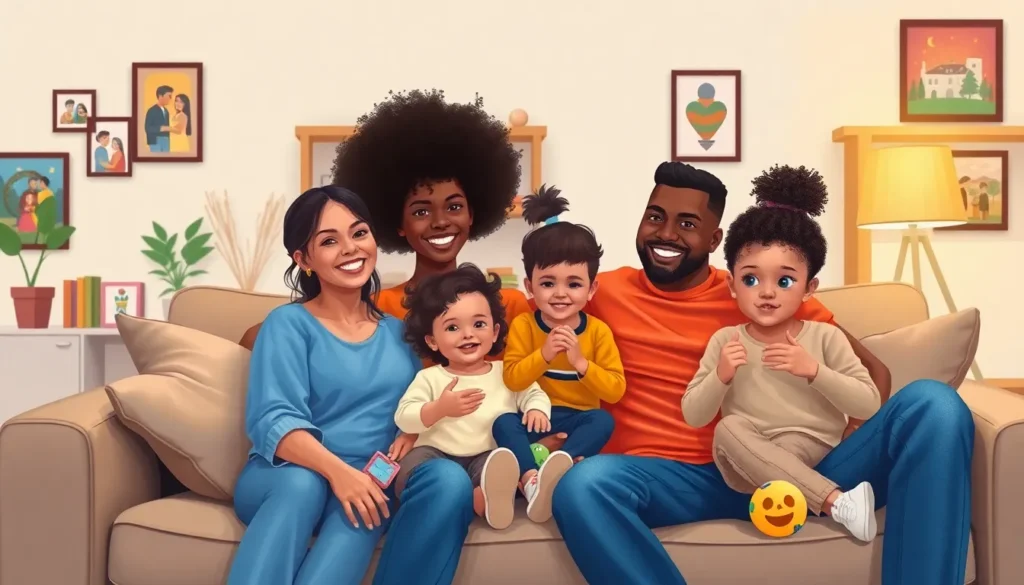Table of Contents
ToggleNavigating the world of child welfare can feel like trying to assemble IKEA furniture without the instructions. Fostering and adoption both offer paths to create loving homes, but they come with their own unique twists and turns. Whether someone’s considering opening their heart as a foster parent or diving into the permanent commitment of adoption, understanding the differences is key.
Fostering is like being a superhero on a temporary mission, providing a safe haven for children in need. Adoption, on the other hand, is the ultimate commitment, bringing a child into a family for life. Each choice has its perks and challenges, and knowing what fits best can make all the difference. So, buckle up as we explore these two rewarding journeys, helping to clarify the road ahead while keeping the laughter flowing.
Understanding Fostering
Fostering plays a crucial role in child welfare by providing temporary care for children in need. This arrangement allows children to experience a safe and nurturing environment while their families undergo challenges.
Definition of Fostering
Fostering involves placing a child into a temporary home where caregivers provide support, guidance, and stability. Caregivers, known as foster parents, offer a safe space during difficult circumstances. While many children remain in foster care for extended periods, fostering is distinct from adoption, as the goal often focuses on reunification with their biological families when possible.
Purpose of Fostering
The primary purpose of fostering centers on ensuring children’s safety and well-being. Emotionally and physically, foster care aims to shield children from harm while addressing their specific needs. This temporary arrangement allows kids to maintain connections with their biological families, facilitating reunification whenever feasible. Foster care also offers crucial support to families facing hardship, offering them time to resolve issues and regain stability.
Understanding Adoption

Adoption represents a formal and permanent arrangement in which an individual or couple becomes the legal parent(s) of a child. This process provides children, often from difficult circumstances, with the opportunity for a stable and nurturing environment.
Definition of Adoption
Adoption involves a legal procedure where the rights and responsibilities of the biological parents are transferred to the adoptive parents. This act creates a lifelong bond, culminating in the child gaining new legal and familial ties. Children adopted may come from various backgrounds, including foster care, relinquishment, or orphanages. Through adoption, new families form, ensuring children’s well-being in safe, loving homes.
Purpose of Adoption
The primary purpose of adoption is to provide children with a permanent family when they cannot remain with their biological parents. This arrangement aims to secure emotional stability and a nurturing environment for children. Adoptive families offer love, support, and guidance, allowing children to thrive. Additionally, adoption can give children a sense of belonging and identity, integrating them into a family that commits to their lifelong welfare. Ultimately, it addresses the needs of children seeking stability while fulfilling family aspirations for parenthood.
Key Differences Between Fostering and Adoption
Fostering and adoption represent distinct paths within child welfare. Understanding their differences is crucial for prospective parents and guardians.
Legal Status
Fostering involves a temporary legal arrangement. Foster parents care for children while biological parents work through challenges. The state retains legal custody over the child, meaning foster parents cannot make permanent decisions. In contrast, adoption creates a permanent legal bond. Adoptive parents become the child’s legal guardians, fully responsible for their care, rights, and welfare. This core difference ensures adoptive families can provide stability, unlike foster arrangements that require adherence to reunification plans whenever possible.
Duration of Care
Fostering usually spans from a few days to several months or years. The duration depends on each child’s situation and the progress of their biological families. This temporary arrangement aims for reunification whenever feasible. Adoption, however, signifies a lifelong commitment. Once the adoption process concludes, adoptive parents and children form lasting familial ties. The difference in duration directly impacts the emotional relationship developed, with adoption fostering a sense of permanence and belonging that foster care cannot guarantee.
Advantages of Fostering
Fostering offers unique benefits that enhance child welfare while providing a fulfilling experience for caregivers.
Flexibility in Commitment
Foster care arrangements allow caregivers to provide temporary support without a lifelong commitment. Parents can decide the length of their involvement based on individual circumstances. This flexibility accommodates those who may want to help children but are not ready for permanent responsibilities. Even short-term placements can create a significant impact. Caregivers can step in during emergencies or crises, providing much-needed stability to children in transitional situations. The ability to choose specific durations of care helps match foster parents’ capacities with children’s needs, maintaining a balance that benefits both parties.
Direct Support for Children in Need
Fostering directly addresses the immediate needs of vulnerable children facing challenging situations. Caregivers provide a safe and nurturing environment, offering emotional support and guidance during difficult times. This support often includes maintaining connections with biological families, which promotes a sense of belonging. Important resources like counseling and educational assistance become available through foster programs, helping children overcome obstacles. With hands-on care, foster parents play a crucial role in stabilizing children’s lives. They contribute to healing, empowering children to work through their challenges while fostering resilience for the future.
Advantages of Adoption
Adoption offers several key benefits that significantly impact children and families.
Permanent Family Structure
Adoption creates a lasting family bond, establishing a legal relationship that fosters a sense of belonging. Legal recognition of this relationship signals commitment, enabling children to feel secure in their new homes. Adoptive parents assume all rights and responsibilities, providing stability that fosters emotional security and social development. Children thrive in environments where they know they are loved and accepted. The permanence of adoption gives them an identity, forming connections that enhance their sense of self-worth.
Long-term Stability for Children
Long-term stability in adoption plays a crucial role in a child’s development. It ensures consistent caretaking, mitigating stress caused by frequent changes in living situations. Children in adoptive homes experience attachment and trust, crucial elements for emotional health. They gain access to supportive networks, including extended family and community resources, which enrich their lives. Stability promotes educational achievement, improving overall life outcomes for adopted children. With this support system, children are better equipped to face life’s challenges with resilience.
Fostering and adoption each play vital roles in the child welfare system. While fostering offers a temporary solution that supports children and families in crisis, adoption provides a permanent home for those in need of stability and belonging. Understanding these differences empowers individuals to make informed decisions that align with their capabilities and aspirations.
Both paths come with unique rewards and challenges, yet each contributes significantly to the well-being of children. Whether one chooses to foster or adopt, the impact on a child’s life can be profound, creating lasting change and nurturing future generations. Embracing either journey fosters hope and healing for children and families alike.










